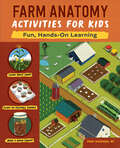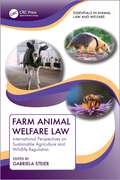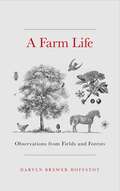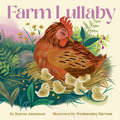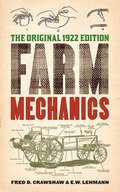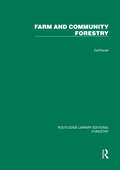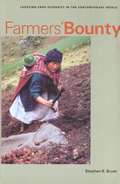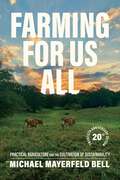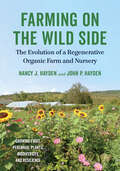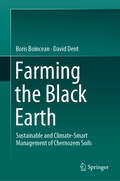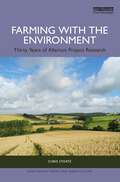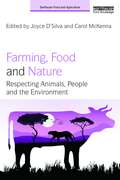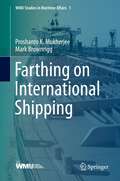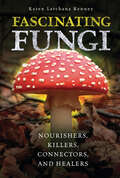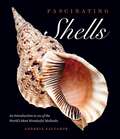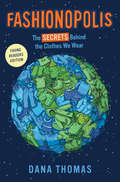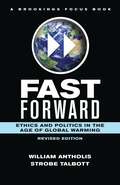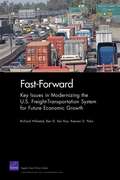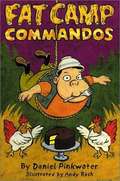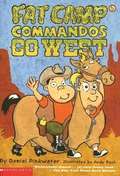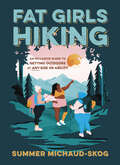- Table View
- List View
Farm Anatomy Activities for Kids: Fun, Hands-On Learning (Anatomy Activities for Kids)
by Dawn AlexanderHelp kids ages 8 to 12 discover how awesome and fun farms can beNo matter where you live, you can learn all about the amazing things that happen on farms. Farm Anatomy Activities for Kids combines the joy of hands-on experiments and activities with easy-to-understand lessons that teach you all about farm life.This farm anatomy activity book helps you think more like a farmer and understand how nature, crops, and animals shape the way we live. You'll learn about all the different parts of a farm, the plants and animals you might find there, and how farms create the food you eat and the material for the clothes you wear.Farm Anatomy Activities for Kids includes:Educational lessons—Learn about the various parts of a farm, how they raise plants and animals, and the ways farms connect to your daily life no matter where you live.Ways to play—Try out cool experiments like growing crops without soil or making a mason bee house.Journal prompts—Reflect on what you've learned about farm anatomy with the thoughtful writing prompts paired with each activity.Take kids on an educational journey down to the farm without ever leaving home.
Farm Animal Welfare Law: International Perspectives on Sustainable Agriculture and Wildlife Regulation (Essentials in Animal Law and Welfare)
by Gabriela Steier Sahana Ramdas Christian Mulgrew de Laire Audrey Amescua Amanda G. Verkest Morgan BoutilierThis book introduces the various aspects of international farm animal protection and wildlife conservation through the lenses of food safety and environmental protection law. Bite-sized chapters focus on a wide range of topics from agrobiodiversity, fishing, and aquaculture to pollinators and pesticides, soil management, industrial animal production, and transportation, as well as international food trade. Animal welfare and biodiversity conservation sit at the core of the selected chapters, each one providing real-world examples to make the complex field easy to understand. Current developments including food safety modernization, blockchain, and COVID-19 considerations are addressed head-on. Farm Animal Welfare Law provides a primer for law school courses and masters’ programs, for practitioners, advocates, and animal enthusiasts alike. Through its emphasis on sustainable food production, this book offers a cutting-edge selection of evolving topics at the heart of the pertinent discourse.
Farm Dogs: A Comprehensive Breed Guide to 93 Guardians, Herders, Terriers, and Other Canine Working Partners
by Janet Vorwald DohnerGain a deeper understanding of your canine friends through these in-depth breed profiles that showcase how working dogs think. From familiar breeds like the Border Collie, Corgi, and Dachshund to the lesser-known Akbash, Puli, and Hovawart, Janet Vorwald Dohner describes 93 breeds of livestock guardian dogs, herding dogs, terriers, and traditional multipurpose farm dogs, highlighting the tasks each dog is best suited for and describing its physical characteristics and temperament. She also offers an accessible history of how humans bred dogs to become our partners in work and beyond, providing a thorough introduction to these highly intelligent, independent, and energetic breeds.
Farm Life: Observations from Fields and Forests
by Daryln Brewer HoffstotDaryln Brewer Hoffstothas observed the fields and forests of her Western Pennsylvania farm for thirty-five years. This collection of twenty-seven essaysexplores birds, mammals, bees, fungi, trees, and other aspects of the natural world. She is a keen observer who delights in sharing what she sees as well as what she learns from naturalists. Her discoveries have strengthened her commitment to protecting the plants and animals that surround us.
Farm Lullaby
by Karen JamesonWith lyrical text from Karen Jameson (Woodland Dreams) and lovely illustrations from Wednesday Kirwan (Eggs Are Everywhere), this bedtime book shows every animal on the farm tucked in tight, drifting off to sweet dreams tonight!Farm-a-bye lullabyField and barn melt into skyMoonbeams shine on evening blushNighttime's blanket settles. Hush.From the largest horse to the smallest mouse, every animal on the farm has a sweet, sleepy bedtime ritual. Curl up like a soft lamb, snuggle like a warm chick, and settle in like a cozy calf, letting this soothing farm lullaby lull even restless little dreamers into a deep and peaceful sleep.This dreamy bedtime book pairs gentle rhymes with charming illustrations of the sleeping rituals of favorite farm animals. A great gift for any occasion, this lovely animal lullaby makes the perfect addition to any nursery, bedroom, or cozy reading nook.SWEET BEDTIME STORY: A soothing and lyrical text is perfect for bedtime read-alouds, engaging little readers with its beautiful illustrations and cozy rhyming narrative before sending them off to sleep with a gentle and loving goodnight.EVERY FARM ANIMAL SAYS GOODNIGHT: Featuring the bedtime rituals of both baby farm animals and their loving parents, this heartwarming book encourages parent/child bonding. Little animal-lovers and their caregivers will love snuggling up to these cozy farm friends.JUST RIGHT FOR THE AGE GROUP: In addition to reinforcing concepts like emotional security and unconditional love, the repetitive, read-aloud text structure also introduces rhyming, language patterns, and concepts like metonymy—ideal for boosting early cognitive development.GREAT GIFTING OPPORTUNITY: This sweet, beautifully illustrated bedtime book makes a gorgeous gift for any special occasion in a child's life, providing a read-aloud experience that infuses each sleepy moment with sweetness and love.LIGHTLY EDUCATIONAL: Scenes of familiar animals in a soothing farm environment, as well as in cozy sleeping places not usually visible to the human eye, serve to reinforce little readers' understanding (and appreciation) of nature and the natural world.Perfect for: Parents, gift-givers, animal and nature lovers
Farm Mechanics: The Original 1922 Edition (Classic Reprint Ser.)
by E W. Lehmann Fred D. CrawshawAn essential agricultural text originally published in 1922, Farm Mechanics is exactly that: a detailed but easy-to-understand manual outlining all the important aspects of working the land.The guide is broken up into sections that cover every aspect of farm work, from woodworking and cement-laying to farm machinery repair. Informative and easy to understand, with close to five hundred illustrations and photographs, Farm Mechanics is both a historical reference for those interested in the history of agriculture and a commonsense tool that outlines essential agricultural skills.For those who want to know more about the golden days of farming, there are plenty of details here to paint a vivid picture of early-twentieth-century farming in the United States, accompanied by detailed photos and illustrations of farm equipment and practices in action.But this isn't just a book of theoretical practices for curious historians either--while some of the skills explained here might admittedly seem inapplicable for modern use (due to advances in technology most farmers aren't taking the time to learn blacksmithing, for instance), other sections, like cement and concrete or rope and harness work for farm animals, contain tools and advice that are still indispensable to the modern-day farmer.
Farm and Comunity Forestry (Routledge Library Editions: Forestry)
by Gerald Foley Geoffrey BarnardIn 1984, when this book was originally published the need to take forestry outside the forests and involve local people in tree growing was widely recognised. Projects to encourage farm and community forestry were launched in over 50 developing countries. This book describes the main approaches which were taken, discussing their scope and limitation. It examines the reasons why people plant trees, and the constraints which prevent them from doing so. It analyses supply and demand systems for wood, and the underlying forces causing tree depletion. Key aspects of programme design and implementation are also covered, including technical problems, the role of extension services and programme planning requirements.
Farmacy Kitchen Cookbook: Plant-based recipes for a conscious way of life
by Camilla Fayed'Farmacy food is what we have all been waiting for. Great tasting healthy food for an optimum mind and body means a better planet for us and the creatures we share it with' - Stella McCartney'Since it opened, Farmacy has been the hottest table in town' - Vogue'THE healthy eating place' - GQ'An oasis of health and happiness' - Harper's BazaarInterested in eating and living in a more conscious way? Want to eat well with nature's best ingredients while being aware of where our food comes from? Think taking better care of the land and people who grow these ingredients is important? Welcome to the Farmacy Kitchen, where you will find inspirational ideas for conscious living and delicious recipes for plant-based eating. The Farmacy ethos is about bringing attention back to nature, simplicity and balance. We love to follow the concept of 'simple abundance' in the food we create, using fresh, colourful and whole foods in inspired combinations for maximum taste, digestion and enjoyment.We know how good food tastes when it's made with love and intention. It's a creative process that brings care into the kitchen to make great-tasting food to nourish the body and energise the soul. A process that you can now bring to your own kitchen with the help of this book.
Farmacy Kitchen Cookbook: Plant-based recipes for a conscious way of life
by Camilla Fayed'Farmacy food is what we have all been waiting for. Great tasting healthy food for an optimum mind and body means a better planet for us and the creatures we share it with' - Stella McCartney'Since it opened, Farmacy has been the hottest table in town' - Vogue'THE healthy eating place' - GQ'An oasis of health and happiness' - Harper's BazaarInterested in eating and living in a more conscious way? Want to eat well with nature's best ingredients while being aware of where our food comes from? Think taking better care of the land and people who grow these ingredients is important? Welcome to the Farmacy Kitchen, where you will find inspirational ideas for conscious living and delicious recipes for plant-based eating. The Farmacy ethos is about bringing attention back to nature, simplicity and balance. We love to follow the concept of 'simple abundance' in the food we create, using fresh, colourful and whole foods in inspired combinations for maximum taste, digestion and enjoyment.We know how good food tastes when it's made with love and intention. It's a creative process that brings care into the kitchen to make great-tasting food to nourish the body and energise the soul. A process that you can now bring to your own kitchen with the help of this book.
Farmers' Bounty: Locating Crop Diversity in the Contemporary World
by Stephen B. BrushOver the course of generations, pre-industrial human agriculture left a bounty of crop diversity across the earth. Bringing together a quarter century of research on the subject and his own field work in the Peruvian Andes, Mexico, and Turkey, Brush (agricultural and environmental science, U. of California at Davis) investigates questions related to patterns of agricultural crop diversity, the impact of farming changes such as industrialization, and methods of conserving diversity. He looks at the questions through lenses of evolutionary science and anthropological ethnobiology. Central to the discussion is the notion of genetic erosion, and Brush discusses both likely causes and possible policy solutions. Annotation ©2004 Book News, Inc. , Portland, OR (booknews. com)
Farming for Us All: Practical Agriculture and the Cultivation of Sustainability (Rural Studies)
by Michael Mayerfeld BellClimate change. Habitat loss. Soil erosion. Groundwater depletion. Toxins in our food. Inhumane treatment of farm animals. Increasing farm worker exploitation. Hunger and malnutrition in the midst of plenty. What will it take for farmers in the United States to embrace sustainable practices?Michael Mayerfeld Bell’s Farming for Us All first tackled this question twenty years ago, providing crucial insight into how the structure of US agriculture created this situation and exploring, by contrast, the practices of farmers who are working together to radically change how they think, learn, and grow. This updated edition of his now-classic work reflects on the lessons learned over the past two decades.Constrained by an oppressive nexus of markets, regulations, subsidies, and technology, farmers find themselves undermining their own economic and social security as well as the security of the land. Bell turns to Practical Farmers of Iowa (PFI), that state’s largest sustainable-agriculture group. He traces how PFI creates an agriculture that engages others—farmers, researchers, officials, and consumers—in a common conversation about what agriculture could look like. Through dialogue, PFI members crossbreed knowledge, discovering pragmatic solutions to help crops grow in ways that sustain families, communities, societies, economies, and environments.Farming for Us All makes the case that for sustainable farming to flourish, new social relations are as important to cultivate as new crops. This book is necessary—and hopeful—reading for anyone concerned about the present and future of food and farming.
Farming on the Wild Side: The Evolution of a Regenerative Organic Farm and Nursery
by Nancy J. Hayden John P. HaydenOne farm&’s decades-long journey into regenerative agriculture—and how these methods enhance biodiversity, pollinators, and soil healthNorthern Vermont&’s Nancy and John Hayden have spent the last 25 years transforming their draft horse–powered, organic vegetable and livestock operation into an agroecological, regenerative, biodiverse, organic fruit farm, fruit nursery, and pollinator sanctuary. In Farming on the Wild Side they explain the philosophical and scientific principles that influenced them as they phased out sheep and potatoes and embraced apples, pears, stone fruits, and a wide variety of uncommon berry crops; turned much of their property into a semi-wild state; and adapted their marketing and sales strategies to the new century. As the Haydens pursued their goals of enhancing biodiversity and regenerating their land, they incorporated agroforestry and permaculture principles into perennial fruit polycultures, a pollinator sanctuary, repurposed greenhouses for growing fruit, hügelkultur, and ecological &“pest&” management. Beyond the practical techniques and tips, this book also inspires readers to develop greater ecological literacy and respect for the mysteries of the global ecosystem. Farming on the Wild Side tells a story about new ways to manage small farms and homesteads, about nurturing land, about ecology, about economics, and about things that we can all do to heal both the land and ourselves.
Farming the Black Earth: Sustainable and Climate-Smart Management of Chernozem Soils (International Year Of Planet Earth Ser.)
by David Dent Boris Boincean'This book deals with the sustainability of agriculture on the Black Earth by drawing on data from long-term field experiments. It emphasises the opportunities for greater food and water security at local and regional levels.The Black Earth, Chernozem in Russian, is the best arable soil in the world and the breadbasket of Europe and North America. It was the focus of scientific study at the very beginnings of soil science in the late 19th century—as a world in itself, created by the roots of the steppe grasses building a water-stable granular structure that holds plentiful water, allows rapid infiltration of rain and snow melt, and free drainage of any surplus.Under the onslaught of industrial farming, Chernozem have undergone profound but largely unnoticed changes with far-reaching consequences—to the point that agriculture on Chernozem is no longer sustainable. The effects of agricultural practices on global warming, the diversion of rainfall away from replenishment of water resources to destructive runoff, and the pollution of streams and groundwater are all pressing issues. Sustainability absolutely requires that these consequences be arrested.
Farming with the Environment: Thirty Years of Allerton Project Research (Earthscan Food and Agriculture)
by Chris StoateThis book examines, discusses and shares over 30 years’ worth of research from the Allerton Project, a research and demonstration farm in the UK which has been carrying out applied interdisciplinary research to explore and explain the need to adapt the management of farmland for environmental protection and to provide public benefits. Designed to provide guidance, feedback and recommendations to farmers, practitioners and policymakers, the Allerton Project is an exceptionally well-documented case study of lowland agricultural land management which has the purpose of meeting multiple objectives. This book draws on the wealth of knowledge built over the past 30 years and unveils and clarifies the complexity of a number of topical debates about current land and wildlife management at a range of spatial scales, explores the underlying historical context and provides some important pointers to future directions of travel. Topics include soil health and management, farmland ecology, development of management practices to enhance biodiversity, natural flood management, water quality and aquatic ecology. Most importantly, the book demonstrates how the findings from this project relate to agricultural and conservation policy more broadly as well as how they are applicable to similar projects throughout Europe. This book will be of great interest to professionals working in agricultural land management and conservation, as well as researchers and students of agri-environmental studies and agricultural policy.
Farming, Food and Nature: Respecting Animals, People and the Environment (Earthscan Food and Agriculture)
by Joyce D'Silva Carol McKennaLivestock production and its use of finite resources is devastating biodiversity and pushing wildlife to the brink of extinction. This powerful book examines the massive global impact caused by intensive livestock production and then explores solutions, ranging from moving to agroecological farming to reducing consumption of animal products, including examples of best practice and innovation, both on land and within the investment and food industries. Leading international contributors spell out the problems in terms of planetary limits, climate change, resources, the massive use of cereals and soy for animal feed, and the direct impact of industrial farming on the welfare of farmed animals. They call for an urgent move to a flourishing food system for the sake of animals, the planet and us. Some offer examples of global good practice in farming or the power of the investment community to drive change, and others highlight food business innovation and exciting developments in protein diversification. Providing a highly accessible overview of key issues, this book creates a timely resource for all concerned about the environmental, social and ethical issues facing food, farming and nature. It will be an invaluable resource and provide inspiration for students, professionals, non-governmental organisations (NGOs) and the general reader.
Farthing on International Shipping
by Mark Brownrigg Proshanto K. MukherjeeThe book provides an introduction to shipping in all its aspects. It is a valuable source of information for students of traditional maritime law as well as for those who seek to understand maritime and shipping services on a global scale. The text includes information and analytical content on national and international practices in shipping, including the age-old dichotomy between freedom in international shipping and the persistent demands of states to control specific maritime areas, as well as the tension between, on the one hand, the desire on the part of sovereign states to regulate and protect their shipping interests and, on the other, the abiding concern and unquestioned right of the international community to regulate the global shipping industry effectively, in order to ensure maritime safety, protection of the environment and fair competition.
Fascinating Fungi: Nourishers, Killers, Connectors, and Healers
by Karen Latchana KenneyFrom the ginormous, extinct Prototaxites to the web of mycelium stretching beneath our feet, fungi have always been all around us. Although scientists estimate that only 10 percent of fungi have been discovered, these findings have proved fantastic. Some fungi are toxic. But others are tasty sources of protein or drive the production of bread, cheeses, and fermented drinks. Some make up medicines to treat health conditions. Others connect vast swaths of trees, capture pollutants in the water and soil, or grow into sturdy but lightweight building materials. Many fungi are even fun to look at—they might ooze blood-like sap, glow at night, and more. What else might fungi be able to do? Karen Latchana Kenney digs deep into the expansive fungal world. Learn about how fungi evolved and became their own kingdom. Then explore the many known fungi and how we use them in food, medicine, technology, and more. Entire communities have sprung up around identifying mushrooms—maybe you’ll even be the next member of your local mycological society. From the most well-known mushrooms to the mycelium hidden beneath our feet, this in-depth text digs deep into the incredible fungal world.
Fascinating Shells: An Introduction to 121 of the World’s Most Wonderful Mollusks
by Andreia SalvadorA New Scientist Best Book of the Year Beautiful photographs of stunning shells from London's Natural History Museum, home to one of the most significant and comprehensive collections in the world. Collected and treasured for their beauty, used in religious rituals, or even traded as currency, shells have fascinated humans for millennia. Ancient and enchanting, dazzling in form and variety, these beautiful objects come from mollusks, one of the most diverse groups in the animal kingdom, including snails, oysters, cuttlefish, and chitons. Soft-bodied, these creatures rely on shells for protection from enemies and their environments, from snowy mountains to arid deserts, in deep-sea hydrothermal vents and the jungles of the tropics, on rocky shores, and in coral reefs. In this book, mollusk expert Andreia Salvador profiles some of the world’s most beautiful and quirky shells, each selected from the more than eight million specimens held in the collection at London’s Natural History Museum. We lock eyes with the hundred-eyed cowry, named after "the all-seeing one," the giant Argus Panoptes of Greek mythology. We see how shells' appearances translate into defense strategies, as with the zigzag nerite, which varies its patterning to deceive and confuse predators. And we meet shell inhabitants, such as the amber snail, which eats earthworms by sucking them up like spaghetti. Reproduced in full color and striking detail, these shells have much to reveal about the history of collecting, the science of taxonomy, and the human desire to understand the natural world.
Fashion Forward: Striving for Sustainable Style (Orca Footprints #22)
by Raina DelisleFashion can be fun, but it can also hurt people, animals and the planet. Fashion Forward: Striving for Sustainable Style goes behind the glitz and glamour to explore the social and environmental issues within the fashion industry. It looks at the history of fashion, from why humans started wearing clothes to the birth of consumerism to the explosion of fast fashion and fashion’s footprint. The book introduces readers to the innovative people, companies and organizations that are taking positive action on fashion. Kids will discover how to make ethical choices and become fashion heroes for the future. There are easy ways we can help transform the fashion industry and still look stylish at the same time! The epub edition of this title is fully accessible.
Fashionopolis (Young Readers Edition): The Secrets Behind the Clothes We Wear
by Dana ThomasA look at fast fashion and its impact on the environment and social justice, perfect for middle grade classroomsDid you ever think about where your jeans come from? How about the people who made your T-shirt, or what happens to the clothes you grow out of when you're done wearing them? The fabrics clothes are made of, the way they are designed and sewn and shipped around the world, and the way we consume them and get rid of them--every step in this process has a big impact on our environment, on the people who work in clothing factories, and on our cultures. This nonfiction book shows us how the clothes we wear--and throw away--every day are made, and what that means for our planet and for people around the world.
Fast Forward
by Strobe Talbott William AntholisFast Forward is equal parts science primer, history lesson, policy prescription, and ethical treatise. This pithy and compelling book makes clear what we know and don't know about global warming; why the threat demands prudent and urgent action; why the transition to a low-carbon economy will be the most difficult political and economic transaction in history; and how it requires nothing less than a revolution in our sense of civic responsibility. William Antholis and Strobe Talbott guide the reader through two decades of climate change politics and diplomacy, explaining the national and international factors that have influenced and often impeded domestic climate legislation and global negotiations. Recent United Nations-sponsored summits have demonstrated that the world cannot wait for a binding global treaty. Instead, the authors believe that the "Big Four" of America, the European Union, China, and India must lead the way forward. They recommend a new international mechanism modeled on the General Agreement on Tariffs and Trade that would monitor national commitments and create incentives for other countries to coordinate their efforts to cut emissions.Antholis and Talbott put their recommendations for legislative and diplomatic action into the larger context of our obligation to future generations, echoing a theme stressed by a diverse coalition of religious leaders calling for ambitious action on climate change. The world we leave to our children and grandchildren is not an abstraction, or even just a legacy; we must think about what kind of world that will be in deciding how we live-and act-today.
Fast-Forward
by Ben D. Van Roo Keenan D. Yoho Richard HillestadEfficient movement of freight within the United States and across its borders is a critical enabler of future U.S. economic growth. The authors provide an overview of the freight-transportation system and the problems it faces, concluding with a discussion of key system-modernization issues, including increasing capacity, making the system less vulnerable to disruption, addressing environmental concerns, and building support for funding.
Fat Camp Commandos
by Daniel PinkwaterKids of all sizes think about being fat or thin or in between. This book is about kids sent to camp to lose weight. Could you go to a camp where the sugarless syrup on the one pancake you get tastes like mouthwash? The camp is in Mountainburg. Home of fortune-telling chickens, the infamous Tator Family, and Camp Noo Yoo. Yes, Camp Noo Yoo, where frantic parents send their pudgy little darlings in hopes that a diet of shredded carrots with raisins will turn them into pre-adolescent fashion plates. Or at least help them shed a few of those socially unacceptable extra pounds. Fed up with the jeering and abuse at Camp Noo Yoo, Ralph and Sylvia Nebula and their new friend, Mavis Goldfarb, hop a bus back home to Pokooksie. There, they seek revenge. Revenge on their parents. Revenge on Dr. Frizzbender, founder of Anti-Fat Day. And revenge on Richard "Dick" Tator, the overweight and overbearing owner of Camp Noo Yoo. Enter the world of Pinkwater, where size is not an obstacle, but a source of strength, and where your favorite poison, be it a Twinkie, a Krispy Kreme doughnut, or a banana split, is always at arms reach. This book may have the shortest chapters in history. There are 62 chapters in 89 pages. Chapter 15 is only 10 words long. Chapter 55 is so short that it's completely missing. Read this book with someone you love--and treat yourself to cookies and milk while you're at it.
Fat Camp Commandos Go West
by Daniel PinkwaterSaddle up, cowpokes, and get ready for the Wild, Wild West! Ralph, Sylvia, and Mavis, the pudgy pranksters from FAT CAMP COMMANDOS, are back -- and this time they are out to shake up the sleepy Western town of Horny Toad.
Fat Girls Hiking: An Inclusive Guide to Getting Outdoors at Any Size or Ability
by Summer Michaud-Skog&“An invaluable guide…Kudos to the author for changing the narrative on inclusiveness, breaking down stereotypes, and building body positivity.&” —Booklist From the founder of the Fat Girls Hiking community comes an inclusive, inspiring call to the outdoors for people of all body types, sizes, and backgrounds. In a book brimming with heartfelt stories, practical advice, personal profiles of Fat Girls Hiking community members, and helpful trail reviews, Summer Michaud-Skog creates space for marginalized bodies with an insistent conviction that outdoor recreation should welcome everyone. Whether you&’re an experienced or aspiring hiker, you&’ll be empowered to hit the trails and find yourself in nature. Trails not scales!
